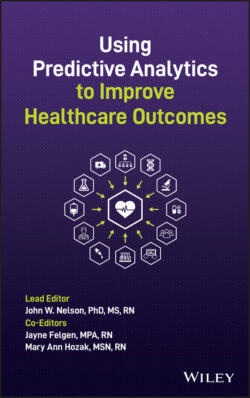Читать книгу Using Predictive Analytics to Improve Healthcare Outcomes - Группа авторов - Страница 74
How Leaders Can Advance the Use of Predictive Analytics and Machine Learning
ОглавлениеThus far it has been reviewed how leadership at every level of an organization can help advance a framework of care such as RBC. What is most promising with all of the technology we now have available to us, however, is that once we set up systems of data collection to monitor change in a culture, we then have the ability to integrate that cultural data into more complex models of measurement. Access to these complex models of measurement moves the organization from mostly retrospective use of data to the proactive use of data to manage healthcare outcomes before they occur.
What if you could know the probability that a proposed change would be effective, before you put a lot of time and energy into implementing the change? What if you could know something about an initiative's effectiveness in your organization before you rolled it out to your staff? That is what predictive analytics and machine learning can offer you.
Many other professions use predictive analytics to learn the predictors of outcomes and then move on to machine learning and forecasting of risk. This became clear at the mathematics conference mentioned in the preface of this book. Dr. Nelson listened to researchers in logistics and mining where they used complex measurement models in simulations to study how changes to the process of work, using existing data, could be understood prior to making actual changes in the work process.
In healthcare, this same technology is available to leaders who are willing to harness the expertise of existing staff members, each possessing unique knowledge in different domains, to form teams capable of working in predictive analytics and machine learning. For example, programmers in most healthcare organizations are typically asked simply to program the data points necessary to track and manage outcomes. What most leaders in healthcare do not realize is if programmers could work closely, for even a short time, with analysts trained in structural and measurement models, many programmers could carry out most of the predictive analytics and machine learning operations that the top payed data scientists do. The challenge with leaving the programmer and analyst alone is that they almost always lack an understanding of the processes of clinical care. If a team of three could work together, a programmer, an analyst, and a clinician who also works in systems (e.g. a clinical leader), they could program their technology to tell the relevant stories of healthcare. This team could design measurement instruments to capture the extent to which a cultural change is taking place and even to predict outcomes.
Dr. Nelson has found that his 11 years as a bedside nurse, his love of using mathematics to tell a story, and his years of work in software development have served him well in “seeing the stories” as he views data. It is these “stories” that make complex measurement models possible. Anything can be measured if its story can be articulated. The challenge is getting people together who can not only hear the story but can then assemble models and use technology to predict what will happen next.
